The Best 21 Plants For Poor Soil (Even A Beginner Can Care For Them)
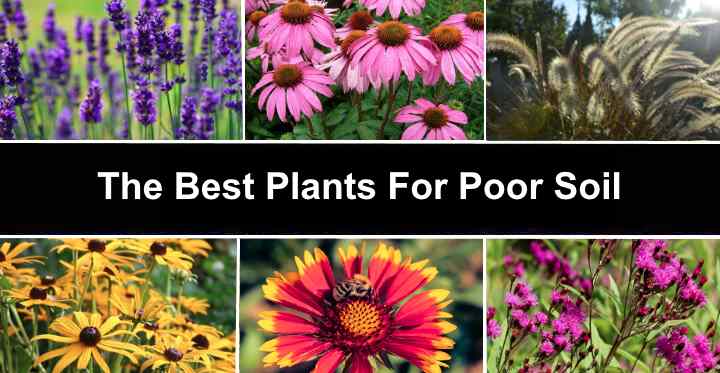
Poor soil in a garden can make planting beautiful flowers, shrubs, and perennials challenging. The good news is that plenty of flowering plants and ornamental grasses thrive in poor soil conditions. Some plants grow in dry, rocky, or poorly-draining soil because of their root system or growth habit. Whether your garden’s soil is sandy, clay, soggy, or with low fertility, many plants adapt and thrive in these conditions.
Read this guide to find the best plants for poor soil to discover how to transform a barren landscape into a lush, colorful, inviting green space.
What is Poor Soil?
Poor soil in gardening refers to soil types with limited nutrients, inadequate drainage, or imbalanced pH levels. These soil conditions can make plant growth challenging. The ground may lack essential organic matter and minerals or be overly compacted. Poor soil types can be described as sandy soil, clay soil, poor draining soil, or dry soil.
In many cases, amendments can improve poor soil, making growing a wide range of plants easier. However, you can search for shrubs and flowers that thrive in poor soil. In most cases, desert plants require poor soils to thrive.
The Best Plants for Poor Soil: Identification Guide with Pictures
Let’s look in detail at the best plants for poor soil.
Stonecrop (Sedum)

Stonecrop (Sedum)
Stonecrop is a hardy perennial flower that blooms from summer through fall and thrives in poor, rocky soils. This drought-tolerant plant is known for its succulent leaves and umbrella-like clusters of star-shaped flowers. Stonecrop flowers also thrive in arid, hot areas where other plants may struggle to survive.
Many varieties of stonecrop are suitable for poor soils. It’s a great plant for rock gardens, borders, or containers. Also, the plant’s tolerance for drought makes it a great addition to xeriscaping and sun-drenched front or backyards. Additionally, stonecrop attracts butterflies and bees, making it a great flower for pollinator gardens.
Depending on your gardening needs, stonecrop varieties can be creeping plants, suitable for full-sun ground cover, or upright flowers to add color, texture, and beauty to a garden.
- USDA Growing Zone: 3 to 9
- Sun Exposure: Full sun to partial shade
- Mature Size: Varies depending on variety, but typically 3” (7.5 cm) to 2 ft. (0.6 m) tall
- Soil Needs: Poor, sandy or rocky soils that drain well
- Water Needs: Low to moderate
Lavender (Lavandula angustifolia)

Lavender is a fragrant purple-flowering shrubby herb that thrives in poor, well-drained soil with few nutrients. Aromatic lavender flowers are small spikes of tubular, star-shaped blooms growing on upright stems. These are surrounded by fragrant, narrow gray-green leaves, creating a bushy mound. Lavender is low maintenance and blooms in summer.
Lavender is a versatile shrub for adding color, fragrance, and texture to herb gardens, flower beds, or containers. Its drought-tolerance qualities make it an ideal addition to xeriscape gardens and desert landscapes. Once established in the ground, it requires little watering or fertilization.
- USDA Growing Zone: 5 to 9
- Sun Exposure: Full sun
- Mature Size: 1 to 3 ft. (0.3 – 1 m) tall and wide
- Soil Needs: Well-drained, chalky, sandy, or loamy soil
- Water Needs: Low to moderate water requirements
Daylily (Hemerocallis)

Daylilies are beautiful, showy, perennial flowers that thrive in various soil types, including sandy to clay. Daylilies, can also tolerate heavy clay soil to some extent, but they generally prefer well-drained, loamy soil. While they can adapt to heavy clay conditions, it is essential to ensure proper drainage to prevent waterlogging.
Daylilies’ eye-catching blooms come in a wide range of colors, including red, orange, yellow, pink, and purple shades. These trumpet-like flowers are on display from late spring through fall, accompanied by their long, slender leaves.
Daylilies endure heat, drought, and constant sunshine. The attractive funnel-shaped flowers are ideal for adding a splash of color to flower beds, borders, and containers. They are useful, colorful plants for soil erosion on slopes and thrive in areas where other flowers struggle. Daylilies also attract hummingbirds and pollinators like bees and butterflies to garden landscapes.
- USDA Growing Zone: 3 to 9
- Sun Exposure: Full sun to partial shade
- Mature Size: 1 to 2 ft. (0.3 – 0.6 m) tall and wide
- Soil Needs: Most soil types that are well-draining
- Water Needs: Can survive drought, but best flowering is in soils that are consistently moist
Ice Plant (Delosperma cooperi)
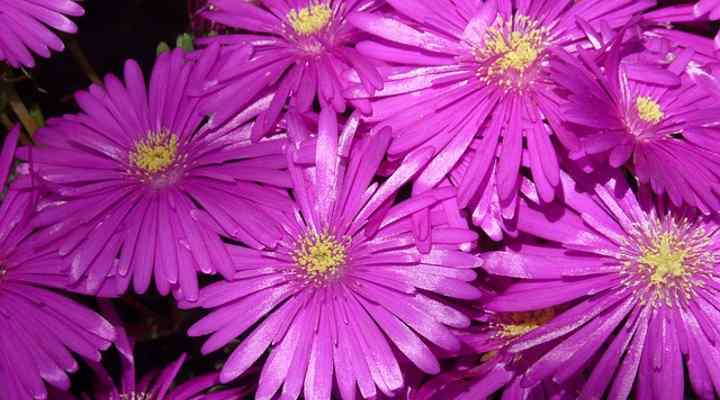
Ice plant is a hardy, heat-loving flowering plant that performs best in dry, sun-drenched soils. This mat-forming plant blooms in summer and fall with masses of vibrant pinkish-purple daisy-like flowers. The drought-tolerant plant has succulent-like fleshy evergreen leaves. Even in hot summers, the flowers require minimal moisture.
Ice plant flowers all summer and fall in purple, pink, orange, and yellow shades. The plant has excellent salt, heat, and drought tolerance, making it versatile for most landscapes. You can use ice flowers in rock gardens, border fronts, coastal gardens, or to cover banks and slopes.
Ice flowers are also a great addition to sunny gardens as fast-spreading ground cover where soil conditions are exceptionally poor.
- USDA Growing Zone: 6 to 10
- Sun Exposure: Full sun
- Mature Size: 3” to 6” (7.5 to 15 cm) tall and up to 24” (60 cm) wide
- Soil Needs: Well-drained, sandy or gravelly soil
- Water Needs: Low to moderate water requirements, drought-tolerant once established
Goldenrod (Solidago)

Goldenrod is a yellow-flowering perennial plant that tolerates dry, poor, clay, and drought-prone soils. The hardy plant is known for its large conical clusters of bright yellow flowers that bloom in late summer and early fall. The plant is easy to grow and requires little care in low-maintenance gardens.
Long-blooming goldenrod is great for attracting pollinators to sunny gardens. Thriving in nutrient-deficient soils, the fluffy sprays of yellow flowers brighten fall borders, foundation plantings, wildflower gardens, and patio containers.
- USDA Growing Zone: 5 to 9
- Sun Exposure: Full sun
- Soil Needs: All soil types that are well-draining
- Water Needs: Low to moderate, drought-tolerant
- Mature Size: 2 to 3 ft. (0.6 – 1 m) tall and 2 ft. (0.6 m) wide
Bigleaf Periwinkle (Vinca major)
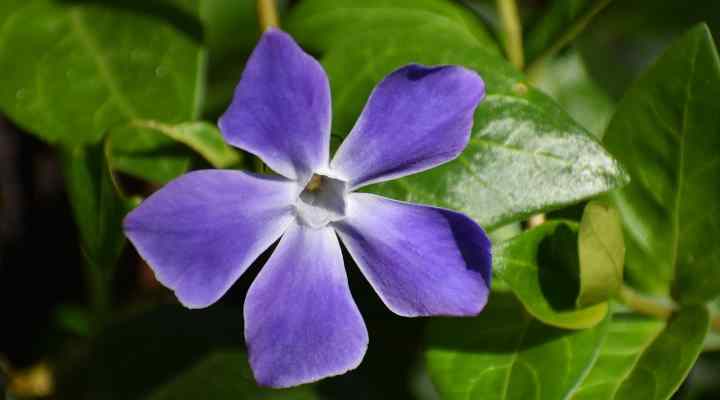
Bigleaf periwinkle is a low-growing evergreen ground cover plant with purple flowers that performs well in dry soils. Bigleaf periwinkle, is known for its adaptability and can grow well in various soil conditions, including poor soil and heavy clay. It can handle periods of drought and does not have specific soil pH requirements. However, it is important to note that while it can tolerate heavy clay soil, good drainage is still essential for its healthy growth.
This periwinkle plant is identified by its large blue or purple five-petalled flowers, glossy green foliage, and spreading stems that help control soil erosion. The purple flowers bloom in summer and fall.
Bigleaf Periwinkle can spread quickly and cover large areas. It’s a popular choice for planting on slopes, suppressing weeds, and growing in full shade. Additional landscaping uses include underplanting shrubs, decorating hanging baskets or window boxes, or filling empty spaces.
- USDA Growing Zone: 7 to 9
- Sun Exposure: Full sun, partial shade, deep shade
- Mature Size: 6” to 24” (15 – 60 cm) tall
- Soil Needs: Tolerates a variety of soil conditions, including drought, dryness, and full shade
- Water Needs: Minimal requirements
Butterfly Weed (Asclepias tuberosa)
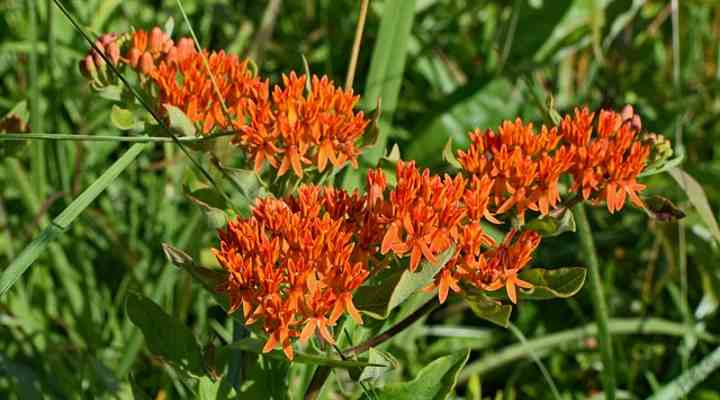
Butterfly weed blooms throughout the summer in poor soils, producing clusters for brilliant orange flowers. The perpetual summer flowers bloom atop upright stems covered with lanceolate leaves. Its orange rounded flower clusters measure 2” to 5” (5 – 13 cm) across. This plant is a favorite orange-flowering plant for butterfly gardens.
Butterfly weed is a low-maintenance plant that is drought tolerant and thrives in hot and sunny conditions. In addition to attracting monarch butterflies, it performs well in borders, mixed flower beds, and cottage gardens. Its orange flowers make excellent cut flowers in dried or fresh floral displays.
- USDA Growing Zone: 3 to 9
- Sun Exposure: Full sun
- Mature Size: 1 to 2 ft. (0.3 – 0.6 m) tall and 2 ft. (0.6 m) wide
- Soil Needs: Well-drained, dry soils, also tolerates nutrient-deficient soils
- Water Needs: Moderate to low water requirements
Indian Blanket Flower (Gaillardia pulchella)
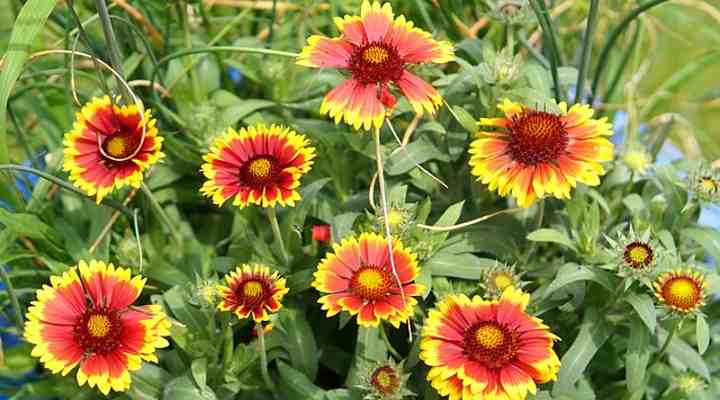
Indian blanket flower is a native wildflower known for its vibrant and colorful red and yellow blooms. Thriving in dry, poor soil conditions, the annual daisy-like flowers measure 2” (5 cm) across and bloom from late spring through fall. The plant has wiry, branching stems and slender, lance-shaped leaves 3” (7.5 cm) long.
Indian blanket flowers create a striking, eye-catching display when blooming throughout the season. The low-maintenance, salt and drought-tolerant plant is a popular addition to wildflower gardens, butterfly gardens, borders, and rock gardens. It reseeds easily, forming dense colonies in poor, arid-prone soils.
Interestingly, Indian blanket flowers perform poorly in rich soils, where they tend to be floppy with few blooms.
- USDA Growing Zone: 2 to 11
- Sun Exposure: Full sun
- Mature Size: 1 to 2 ft. (0.3 – 0.6 m) tall and 1 ft. (0.3 m) wide
- Soil Needs: Well-drained, average to poor soils, including salty soil
- Water Needs: Low to moderate water requirements
Purple Coneflower (Echinacea purpurea)
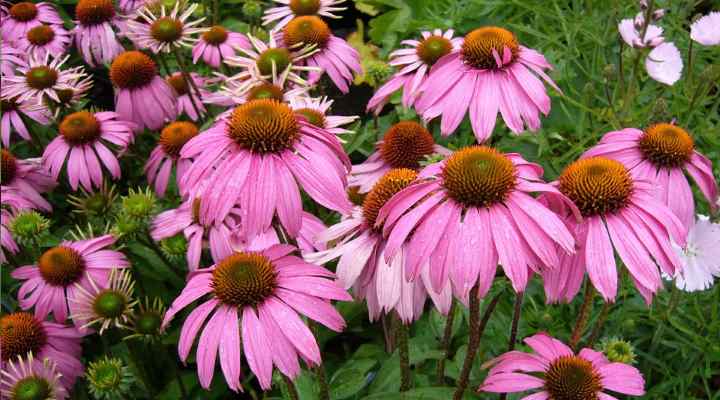
Purple coneflower is a hardy herbaceous perennial flower tolerant of drought, humidity, heat, and poor soils. It blooms in spring and summer with stunning flowers consisting of purple petals and a cone-shaped center. Growing up to 5 ft. (1.5 m) tall, purple coneflowers are rich in nectar, and their fall seeds attract birds.
Purple coneflowers thrive in a variety of soil conditions, including nutrient-deficient soil. With their drooping rays, the tall, showy purple flowers add a pop of color to the back of flower beds, foundation plantings, wildflower gardens, and perennial borders.
- USDA Growing Zone: 3 to 8
- Sun Exposure: Full sun
- Soil Needs: Well-drained soil, can tolerate poor soil and drought
- Water Needs: Minimal requirements once established
- Mature Size: 2 to 5 ft. (0.6 – 1.5 m) tall and 2 ft. (0.6 m) wide
Black-Eyed Susan (Rudbeckia hirta)
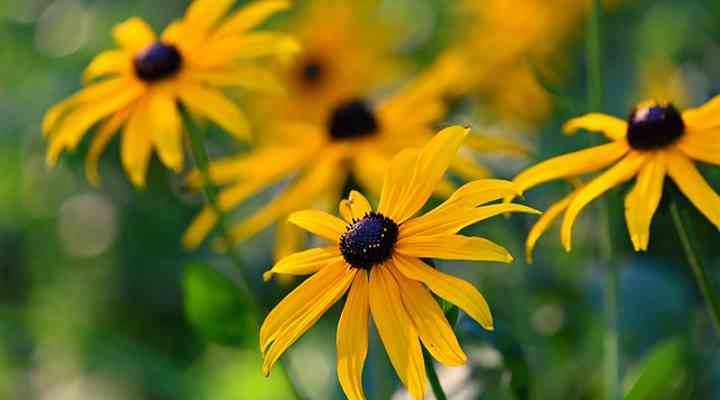
Black-eyed Susan adds a burst of bright yellow color to any garden growing in dry to moist soil. The daisy-like flowers have vibrant yellow petals in a ray surrounding a dark, chocolate-brown center. Black-eyed Susan grows up to 3 ft. (1 m) tall and blooms throughout summer and fall.
Black-eyed Susan flowers don’t require much care or nutrient-rich soil to bloom for a long time. The tall yellow-flowering plants tolerate clay and sandy soils and don’t wither in dry heat. They are ideal for adding a splash of yellow to perennial borders, flower beds, or container plantings.
- USDA Growing Zone: 3 to 9
- Sun Exposure: Full sun
- Mature Size: 2 to 3 ft. (0.6 – 1 m) tall and 1 to 2 ft. (0.3 – 0.6 m) wide
- Soil Needs: Tolerates a variety of soil conditions, including dry ground
- Water Needs: Occasional watering in dry seasons
Sneezeweed (Helenium autumnale)
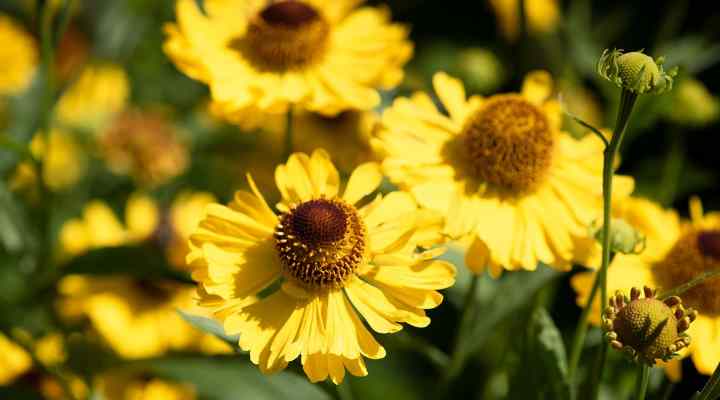
Sneezeweed is a perennial yellow-flowering plant that blooms in the late summer and early fall. Tolerant of any soil conditions, the clump-forming perennial is characterized by its yellow ray flowers with golden brown centers and narrow lanceolate leaves. Sneezeweed flowers are ideal for adding vibrancy to summer and fall landscapes.
Being tolerant for medium to wet soil, landscaping uses for sneezeweed include growing beside streams and ponds, borders, naturalized areas, or cottage gardens.
- USDA Growing Zone: 3 to 8
- Sun Exposure: Full sun
- Mature Size: 3 to 5 ft. (0.9 to 1.5 m) tall and 2 to 3 ft. (0.6 – 1 m) wide
- Soil Needs: Moist, medium to wet soils
- Water Needs: Requires regular watering to keep the ground moist
Russian Sage (Perovskia atriplicifolia)
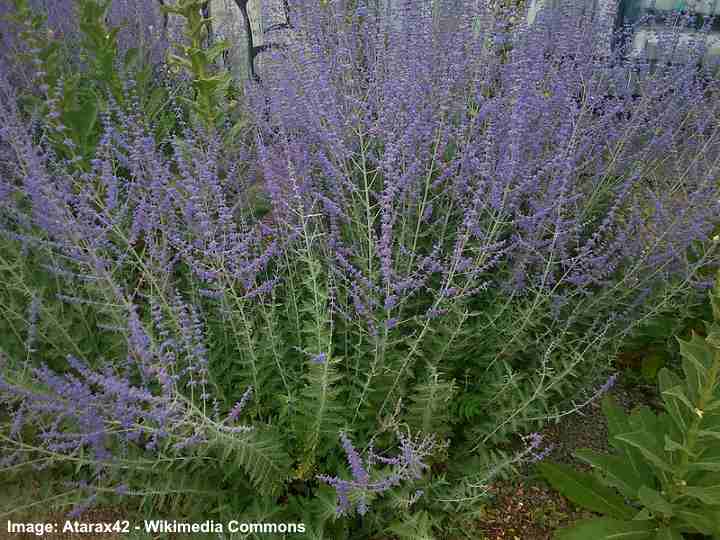
Russian sage is a full sun woody perennial with tall, spiky stems that bloom in lilac shades from mid-summer through fall. Russian sage is prized for its beautiful, airy foliage and lavender-blue flowers resistant to poor soils, heat and drought.
The low-maintenance Russian sage has spikes of lilac flowers, aromatic green-gray leaves, and a bushy appearance. Its long-lasting flowers are ideal for adding color and texture to xeriscape gardens. Additionally, the silvery-gray foliage of Russian sage adds texture and interest to borders, foundation plantings, and herb gardens.
- USDA Growing Zone: 4 to 9
- Sun Exposure: Full sun
- Mature Size: 3 to 4 ft. (1 – 1.2 m) tall and wide
- Soil Needs: Well-drained soils, tolerant of salt and drought
- Water Needs: Minimal watering requirements
Tickseed (Coreopsis)

Tickseed has bright and cheerful yellow flowers that tolerate humidity and dry conditions. Tickseed flowers have lobed petals in a ray form, ovate to elliptic green leaves, and have a long-blooming season. Some tickseed flowers bloom in orange, pink, yellow, white, and red shades.
Tickseed is low maintenance and tolerant to drought. It is a great choice for adding color to flower beds, borders, ground cover, or containers where the soil lacks nutrients or moisture.
- USDA Growing Zone: 4 to 9
- Sun Exposure: Full sun or partial shade
- Soil Needs: Well-drained soil
- Water Needs: Occasional watering in the hottest part of summer
- Mature Size: 1 to 3 ft. (30 to 90 cm) tall
Blazing Star (Liatris pycnostachya)
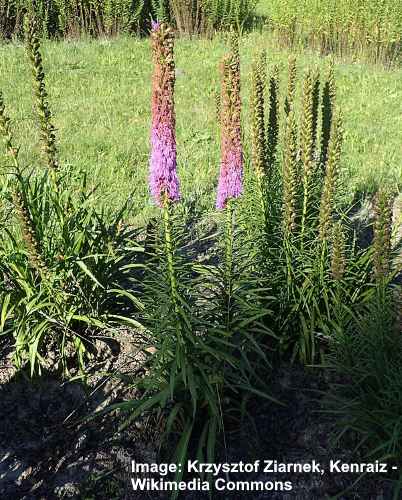
Blazing star blooms in summer with tall spikes of densely packed pink-purple flowers. The plant tolerates heat, poor soils, humidity, and drought. In these conditions, the blazing star produces deep rose-purple fluffy flowers and grassy foliage and grows up to 5 ft. (1.5 m) tall.
Blazing star is a great addition to perennial borders, wildflower gardens, foundation plantings, and patio containers. Its tall flowers add a spectacular vertical accent.
- USDA Growing Zone: 3 to 9
- Sun Exposure: Full sun
- Soil Needs: Moist, well-drained soil, tolerant nutrient-deficient soils, drought, humidity, and heat
- Water Needs: Drought-tolerant once established, water sparingly
- Mature Size: 2 to 5 ft. (0.6 – 1.5 m) tall and 2 ft. (0.6 m) wide
Pot Marigold (Calendula officinalis)

Marigolds are showy low maintenance flowers that look great in your front yard
Pot marigold is one of the easiest annual flowers to grow in poor, dry soils. The hardy flowering plant is identified by its vibrant yellow or orange daisy-like blossoms 4” (10 cm) wide, aromatic lanceolate leaves, and long-blooming season. Pot marigold is a great addition to butterfly gardens, borders, edgings, or orange-flowering ground cover.
- USDA Growing Zone: 2 to 11
- Sun Exposure: Full sun or partial shade
- Soil Needs: Well-drained, poor and dry soils
- Water Needs: Occasional watering during warm, dry spells
- Mature Size: 1 to 2 ft. (0.3 – 0.6 m) tall and wide
Perennial Sunflower (Helianthus × laetiflorus)

Perennial sunflower produces large, vibrant yellow star-shaped flowers, regardless of the soil conditions. The ray flowers consist of lobed petals surrounding a brownish or green disk, thick, leathery leaves, and a long-blooming time. The yellow-flowering perennial tolerates sandy, loamy soils.
Perennial sunflowers are a great choice for adding height and color to borders, flower beds or as a focal point in the garden. They also attract pollinators like bees and butterflies, making them a beneficial addition to garden landscapes.
- USDA Growing Zone: 4 to 8
- Sun Exposure: Full sun or partial shade
- Mature Size: Up to 7 ft. (2.1.m) tall
- Soil Needs: Well-draining sandy soils
- Water Needs: Moderate watering, drought-tolerant
Sundrops (Oenothera fruticosa)
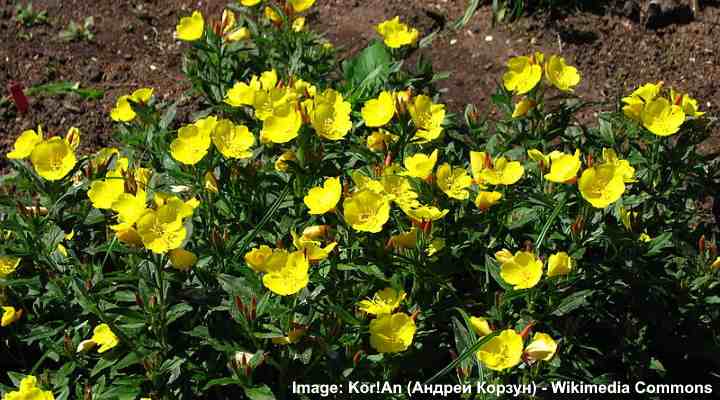
Sundrops are pretty yellow, saucer-shaped flowers that thrive in light shade and poor, drought-prone conditions. The clump-forming perennial blooms in spring and summer with masses of bright yellow flowers. These contrast nicely with the lanceolate dark green leaves and hairy stems. The cup-shaped blossoms have a sweet fragrance that attracts bees and butterflies.
Low-maintenance sundrops flowers are ideal for adding a pop of yellow color to ground cover, borders, rock gardens, or wildflower plantings.
- USDA Growing Zone: 4 to 8
- Sun Exposure: Full sun or partial shade
- Mature Size: 1 to 2 ft. (0.3 – 0.6 m) tall and wide
- Soil Needs: Tolerates poor soil conditions, including drought
- Water Needs: Moderate water requirements
Rosemary (Rosmarinus officinalis or Salvia rosmarinus)

Rosemary is an evergreen shrub with pale purple flowers that bloom in spring or early summer. The plant is known for its aromatic, narrow leaves, and woody stems.
The rosemary bush thrives in poor soils that get little moisture. It can thrive in various soil types, including dry or sandy soils. It prefers well-draining soil and is known to withstand drought once established, making it a suitable option for gardens with less fertile or poor-quality soil.
This versatile plant is ideal for mixed borders, rock gardens, a low hedge, or in containers on sunny patios or decks.
Deer and rabbits don’t eat rosemary because of its strong scent and taste. These animals usually avoid it in favor of more palatable options. Voles may occasionally feed on the roots of young rosemary plants, especially in areas with limited food sources or during challenging environmental conditions. However, mature rosemary plants are less likely to be a preferred food source for voles.
- USDA Growing Zone: 8 to 11
- Sun Exposure: Full sun
- Mature Size: 2 to 6 ft. (0.6 – 1.8 m) tall and up to 5 ft. (1.5 m) wide
- Soil Needs: Well-drained, poor soils
- Water Needs: Minimal water requirements
Fountain Grass (Pennisetum)
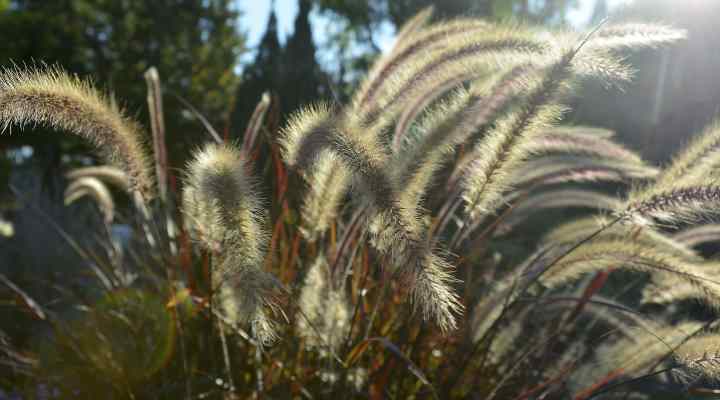
Fountain grass is a popular ornamental grass that grows well in sandy or chalky soils. It is generally known for its adaptability and ability to thrive in various soil conditions, including poor soil. Fountain grass can tolerate a wide range of soil types, including dry and less fertile soils, making it a suitable option for gardens with less-than-ideal soil quality.
The cold-hardy fountain grass is characterized by its arching, fountain-like growth habit and feathery plumes of brown to purple bottlebrush flowers that sway in the breeze. The fuzzy flower spikes bloom from spring through fall.
This low-maintenance, drought-tolerant clumping grass is ideal for landscaping borders, foundation plantings, or patios when planted in containers. Its decorative plumes add visual interest to landscapes and are ideal for dried flower arrangements.
- USDA Growing Zone: 6 to 9
- Sun Exposure: Full sun or partial shade
- Mature Size: 2 to 3 ft. (0.6 – 1 m) tall and wide
- Soil Needs: Well-draining, dry soils
- Water Needs: Moderate to low water requirement
Hens and Chicks Succulent (Sempervivum tectorum)
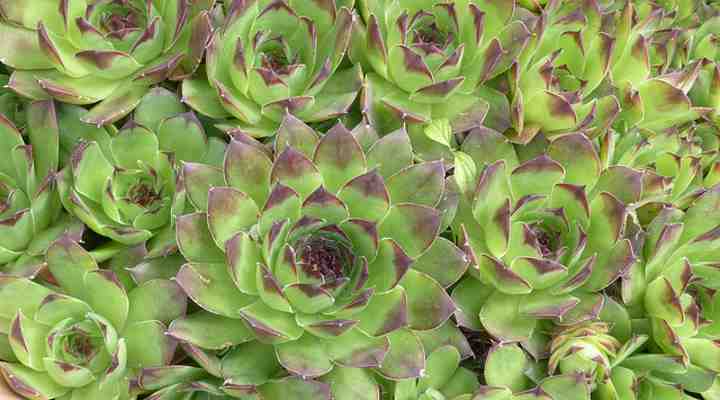
Hens and chicks are ground cover succulents that are known for their hardiness and ability to thrive in poor soil conditions. They can grow in various soil types, including poor, sandy, or rocky soils, making them a suitable choice for challenging environments.
Hens and chicks can also grow in clay and heavy clay soils. While they prefer well-draining soil, they can tolerate periods of moisture and are generally resilient in heavy clay conditions, provided that the soil does not become waterlogged.
Their shallow root system allows hens and chicks to establish themselves in shallow or poor-quality soil, making them a popular choice for rock gardens, slopes, and other challenging planting areas. Proper drainage, however, is crucial for their optimal growth and health.
Because of their hardiness, drought tolerance, and ability to survive all sorts of conditions, they are also called ‘live forever’ plants. Even in freezing cold climates, these pretty succulents stay green all year round.
Hens and chicks are attractive succulent plants that grow in the shape of beautiful rosettes up to 4” (10 cm) across. The fleshy leaves can be in a number of colors, including blue, red, green with pink blushing, or green and purple tips.
Although these beautiful succulents only grow for about 3 years, the number of ‘chicks’ they produce means that they seem to live forever.
- USDA Growing Zone: 3 to 8.
- Sun Exposure: They prefer full sun but can tolerate partial shade
- Mature Size: Sempervivum generally forms low, compact rosettes, reaching a mature size of around 3 to 5 inches (7.5 to 12.5 cm) in height and 6 to 12 inches (15 to 30 cm) in spread
- Soil Needs: They are adaptable to various soil types, including poor, sandy, rocky, and clay soils, as long as the soil is well-draining
- Water Needs: Low water needs and is drought-tolerant once established, making it well-suited for arid and dry conditions
Candytuft (Iberis sempervirens)
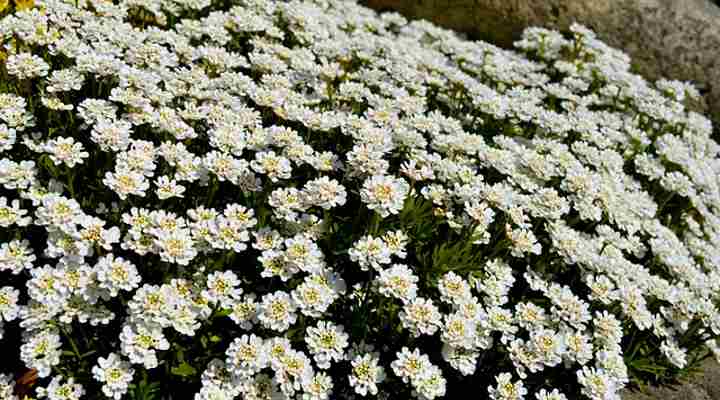
Candytuft is a flowering, fast-growing ground cover plant for full sun that is deer- and drought-resistant. It can thrive in poor soil conditions, making it a suitable choice for gardens with less fertile or nutrient-depleted soil. It is relatively adaptable and can tolerate various soil types, including poor, rocky, or sandy soils.
Candytuft is a spreading evergreen perennial. it’s a low-growing bushy plant that produces carpets of dainty white flowers in early summer. After blooming, removing the spent flowers allows you to enjoy the plant’s rich green leaves throughout the winter.
Although candytuft is a quickly-spreading clumping plant, it is not considered an invasive, aggressive ground cover.
- USDA Growing Zone: 3 to 9
- Sun Exposure: It thrives in full sun to partial shade
- Mature Size: Candytuft typically reaches a height of 6 to 12 inches (15 to 30 cm) with a spread of 1 to 2 feet (30 to 60 cm)
- Soil Needs: It can grow in poor, rocky, or sandy soils, provided there is adequate drainage
- Water Needs: It has average water needs and is relatively drought-tolerant once established. However, regular watering during dry periods can promote healthier growth and blooming
Related articles:
